Crocodylus ventrumalbis
| Inyurstan Crocodile | |
|---|---|

| |
| Crocodylus ventrumalbis | |
| Scientific classification | |
| Kingdom: | Animalia
|
| Phylum: | Chordata
|
| Class: | Reptilia
|
| Order: | Crocodilia
|
| Family: | Crocodylidae
|
| Genus: | Crocodylus
|
| Species: | C. ventrumalbis
|
| Binomial name | |
| Crocodylus ventrumalbis Gardner, 1817
| |

| |
| Range of C. ventrumalbis in Inyursta | |
Crocodylus ventrumalbis, common name: Inyurstan Crocodile (also known as the Inyurstan Whitebelly or Cocodrilo de Rayas) is a moderate sized species of crocodile found in swamps and rivers of Inyursta and Gran Cuscatlan. It is mildly aggressive, with smaller specimens being more docile while large males and nesting females are markedly more territorial and likely to attack humans.
Physical Description
The Inyurstan Crocodile is easily identifiable for its white or cream-colored underbelly contrasted with a dark backside, as well as its vibrant stripes as hatchlings and juveniles. This species retains its juvenile patterns much longer than other related species, and keeps its tail stripes almost its entire lifespan.
It's snout is longer and more slender than the sympatric American crocodile, but not to the degree of the similar San Jorgé Crocodile or Orinoco crocodile species.
Adult males on average reach approximately 8.5ft (2.6m), but can exceed 11ft in length. Females average around 6ft (1.8m) as adults, but like males can reach much larger sizes. The largest recorded pure specimen of C. ventrumalbis was a 16.9ft (5.1m) bull male from an oxbow lake south of Porté Maceau in the Rio Neige Basin.
Habitat
This species is found mostly in freshwater environments, including rivers, lakes and cenotes. It generally prefers areas with heavy vegetation on the shoreline or with an abundance of aquatic or riparian tree cover; they are less common (albeit not absent from) open-grass swamplands and flooded savannas. As a true crocodile, this species can tolerate salt water, and minor populations can be found in the mangroves of northern Marindino. Scientists also believe this is how the species was able to populate islands and landmasses seperated by large bodies of water.
Intraspecific Relationships
Crocodylus ventrumalbis shares at least one or more parts of its range with a combined total of five other crocodilian species: the American Crocodile (Crocodylus acutus), San Jorgé Crocodile (Crocodylus ferox), Spectacled caiman (Caiman crocodilius), Gold-Banded Caiman (Paleosuchus orosi) and the Forest Caiman (Paleosuchus sp.).
Because of its moderate size, C. ventrumalbis has been known to be a predator of ther smaller caimans as well as a prey item for the larger American and San Jorgé crocodiles.
This species shares both range and habitat with the Spectacled Caiman. As mentioned above, the Inyurstan Crocodile prefers flooded forests or rivers in wooded areas, leaving open-grass wetlands to be dominated by the common caimans. In areas such as oxbow lakes and swamps, recent studies have found that the caimans adopt a modified diet of almost entirely invertebrates with some fish, while the crocodiles adopt a modified diet of mammalian, reptilian and avian prey.
Interbreeding between C. ventrumalbis and C. acutus has been recorded on rare occasions, most hybrids originating in the Rio Neige Delta of Northern Marindino. The infamous supercroc Petí Augusto is one such hybrid. Despite overlapping range in the Rio Preto Basin of Cuscatlan, no hybrids between Inyurstan crocodiles and San Jorgé crocodiles have yet to be documented.
